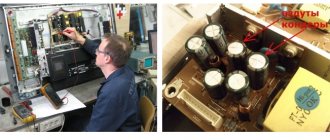Needle-punched geotextile Brane Geo Pro 120 (1.5*25 m) 37.5 m2
1575 ₽ More details
Needle-punched geotextile Brane Geo Pro 120 (75 m2)
3000 ₽ More details
Mechanical keyboards
In order to repair the Panasonic TX PR42UT30 TV with your own hands, you need to understand exactly what the main features of its most frequent breakdowns are. Which parts can be repaired and which can only be replaced. And what are the symptoms of certain types of malfunctions.
Troubleshooting on Panasonic TVs
A Panasonic TV, like any other household appliance, may experience various malfunctions. Most often they are associated with a breakdown of the power supply, incorrect scanning, or lack of power to the matrix. Most breakdowns can be fixed with your own hands.
This article discusses issues related to the repair of this TV.
Doesn't turn on
Most often, Panasonic LCD TV repair is required when it does not turn on. There may be several reasons for this problem. You should look for the problem in:
- short electrical circuit;
- reduced load;
- kinescope malfunctions;
- microcontroller;
- problems with the protective circuit.
Often, consumers encounter a squeaking sound when trying to turn on the device - the Panasonic TV starts beeping, but although it beeps, it does not turn on fully.
The first thing to look for is a decrease in resistance or an electrical short circuit in the resistance. They check the transistor number Q551, the zener diode D856 and the urgent transformer. Resistance in power circuits is measured at 8, 14, 15 and 22 Volts. The easiest way to determine a transformer malfunction is visually, since this causes parts to burn and the plastic case to swell.
In this video you will learn more about repairing this TV:
In some cases, a breakdown occurs due to malfunctions in several parts at once. Most often, consumers have to deal with a combination of breakdown of electrolytic capacitors on secondary circuits and breakdown of TDKS. This situation arises due to the fact that the control circuit in the key transistor fails, which entails an increase in the voltage at the output of the power supply up to three times.
Another common reason that a Panasonic TV does not turn on is the loss of filter capacitors' capacity. As a result, the voltage drops from the prescribed 300 Volts to 200-250 Volts, and then to zero as soon as the TV turns off.
Mechanical impacts of great force in the form of impacts and falls are another reason for the occurrence of such defects. The presence of cracks is the first thing that the printed wiring of the model is checked for. They usually occur where the line transistor is installed.
Another malfunction is observed when the mode indicator flashes red constantly, even after switching to operation mode from standby. The reason may be in the standard situation listed above, or it may be due to broken buttons. Similar blinking is observed when two front panel buttons are pressed simultaneously or one of them is stuck due to deformation of the case (for example, its skew).
Important!!!! Problems with the microcontroller are another possible reason why there is no image on the device screen.
The issue here could be either insufficient power supply or the performance of the RESET circuit and quartz. To check the condition of the circuit, turn on the Panasonic TV and see if pin 54 of IC1101 is held at zero potential at the beginning. Immediately after this, in normal condition, the voltage increases by 5 Volts. It is equally important to check for the presence of high potential at pin 35 of IC1101 and its passage to the base of Q846. If, when switching from standby mode to working mode, a high potential does not appear, then this is a clear sign of a breakdown of the microcontroller.
No sound
If the TV sound does not turn on along with the image, then the reason most likely lies in the lack of voltage supply. You can understand whether it exists without the presence of special devices - if you feel the effect of static electricity from the screen, then everything is fine.
But there may be no current in different parts of the device. Therefore, they also additionally check whether it is fed directly to the kinescope. This is also easy to find out - just check whether the thread glows at the neck. In the absence of such a glow, the current level is measured with an oscilloscope. To find out the suspected cause of the problem, ring the thread. It allows you to identify a violation of the soldering on the chassis base, a break in the filament itself, or insufficient contact of the panel with the terminals.
Problems arise due to lack of electricity supply
But the problem may not only be problems with the supply of electricity to the kinescope. An equally frequent breakdown of Panasonic models is the failure of the IC601 AN5693K video processor. To identify this failure, increase the voltage level to accelerate. Screen flare is the main sign that it’s all about the processor. After this, it is necessary to determine whether there are signals from the red, green and black channels at the input of the board and whether all connectors are connected securely. The main way to get the information you need is to set saturation, brightness, and contrast to their maximum values.
The lack of output signals combined with too low electrical current and the arrival of a video signal at pin 31 of IC601 indicates the need to replace IC601.
The accelerating voltage may also be absent or insufficient. A sign of this is that the screen does not light up when you turn on the Panasonic TV. A sufficient level ranges from 200 to 800 Volts. As a result of problems with accelerating voltage, breakdowns occur in filter capacitors and picture tubes. Without power, the most important part remains - the emergency transformer.
Can't pick up channels
Many consumers order Panasonic plasma TV repairs because their model suddenly stops receiving channels. In most cases, this problem is software related and requires contacting a service center or resetting all settings to factory settings.
The long-term life of your TV is entirely up to you!
In most cases, equipment fails due to improper use. Do not forget that the TV also has certain rules of use, which simply cannot be violated, otherwise breakdowns will not be such a rare occurrence.
The inverter is the most vulnerable and expensive part of the TV. Even craftsmen who undertake TV repairs most often simply fix it, because buying a new one is simply expensive.
This part fails most often on LG and Samsung . And this happens due to continuous or improper use of the TV. Remember these rules:
- Everyone needs rest, even household appliances. Continuous operation only leads to rapid wear of spare parts, and, consequently, to breakdowns in the system;
- Regular cleaning of the TV is the key to long-term viewing of films and TV series. Dust and dirt can negatively affect the operation of equipment, even causing a short circuit. This way you can burn all the wiring! Be careful and wipe your TV often;
- Moisture is contraindicated for electrical appliances. Do not flood your TV with water or other liquid, as this can simply burn it;
Remember that the service life of your equipment depends only on you!
Frame scan repair
Sometimes owners of Panasonic models have to deal with a situation where the screen on the TV lights up and the image itself lights up, but the latter has incorrect parameters - it is either too narrow or too wide. In rare cases, instead of a normal image, only a horizontal line is seen. Such a breakdown is called a frame scan malfunction.
If such a scan is completely absent (that is, there is only a horizontal line on the screen), then the first thing to do is check how good the power is at pin 6 of transistor IC401. In a normal situation, the voltage value is 30 Volts. If it is not there at all, then they look for a fault in the resistance circuit of the transistors marked R434, C507, D505 and R504. Most often, it is the last one among them that fails. If everything is fine with the circuit, then make sure that there is a sawtooth voltage at the input. It is equally important to check how well the feedback circuit works and whether the OS connector is securely connected.
If the image is present on the screen, but there are problems with linearity or the vertical dimensions are violated, then pay special attention to the OOS circuit. If the picture above is too stretched, it indicates that the power level is insufficient. This is usually associated with an increase in resistance in R504 from one to ten ohms. Therefore, it is important to have a sufficiently accurate ohmmeter available.
Why else can sound work, but there is no picture?
New TVs may have a screen-free feature. Roughly speaking, if you like to listen to TV in the background, but can’t watch it because you’re busy, then it will just help.
You may have turned it on accidentally, which is why there is no image. Click the buttons on the remote control, especially try “MENU”.
If the image appears in the settings, then it’s probably in this mode! By the way, most often it is installed on the following brands of TVs:
- Philips;
- Sony;
- LG;
- Samsung;
- Toshiba.
If this does not help to return the image, then the problem is at the hardware level. Let's take a deeper look at the problem!
Power supply: when repairs are needed
From time to time, Panasonic TV owners have to deal with power supply failures and other power supply errors. A common sign of such malfunctions is a situation when the TV does not want to turn on at all, or after several turns on and off, the light is on, but the image does not turn on.
The presence of this problem is quite easy to determine during a visual inspection. Broken capacitors look swollen, and there are dark spots on the board. The resistance also changes, which normally should not exceed 10 kOhm. In addition, ceramic capacitors often burn out. Any correction of such problems is possible only by replacing broken parts.
The TV doesn’t turn on – the TV technicians are exchanging their experiences.
(Only for specialists and colleagues! We don’t prohibit ordinary users from reading, and we categorically do not recommend getting into it with a soldering iron!)
Currently, data on TV repairs from the association of service centers “Opora-Service” is being processed and compiled. The link to this section will be active in a month.
- Samsung TV does not turn on, goes out, clicks
- LG TV does not turn on or turns off immediately
The indicator flashes in a certain sequence
This method of self-diagnosis allows you to quickly identify a faulty component. The service instructions for a specific model contain so-called error codes, in which each combination of blinking indicators corresponds to possible failures of various components of the television receiver. This makes life much easier for the telemaster during diagnostics, guiding him along the right path. For example, 13 LED blinks after a pause on a Sony TV on the FIX2 chassis indicates problems with the backlight. The inverter or lamps may be faulty, so we will diagnose them. As an example, I will give a table with error codes for Philips TVs on the Q552.1E LA chassis. We see the first level of errors (Layer 1) immediately when a defect occurs, the second level (Layer 2) can be observed if the receiver is switched to service mode.
To summarize, we can say that the behavior of the indicator light on the TV when a malfunction occurs can provide a lot of useful information for successful diagnosis and localization of the defect in a specific unit, contributing to the successful repair of the TV as a whole.











